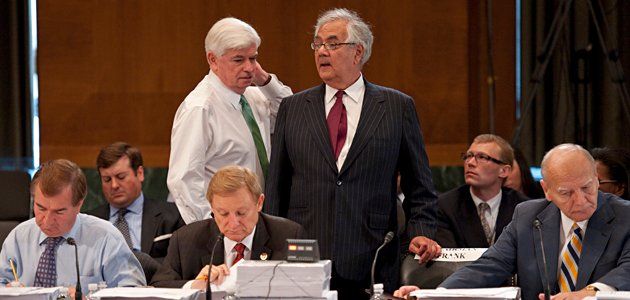
Glass-Steagall, meet Dodd-Frank. President Obama, in his comments on the landmark bill on Friday, proclaimed it "the toughest financial reform since the one we created in the aftermath of the Great Depression." And indeed in many ways this vast and sprawling attempt to address the causes of the 2007–09 financial disaster is very impressive: it brings trillions of dollars in "dark" trading in over-the-counter derivatives into the open; it creates new, tough watchdogs for credit card and mortgage companies as well as banks; and it gives the government new tools to liquidate failing firms.
But in one respect, the nearly 2,000-page bill marshaled through Congress by Sen. Chris Dodd and Rep. Barney Frank falls short of that earlier, Depression-era standard. Whereas Glass-Steagall substantially altered the structure of the financial system and required the creation of brand-new kinds of firms, Dodd-Frank effectively anoints the existing banking elite. The bill makes it likely that they will be the future giants of banking as well. Legislators touted changes that would restrict proprietary trading by banks and force them to spin off their swaps desks into separately capitalized operations. But banks get to keep the biggest part of their derivatives business, which is dominated by interest-rate and foreign-exchange swaps. Some 80 to 90 percent of that business will remain within the banks, and J.P. Morgan, Goldman Sachs, Citigroup, Bank of America, and Morgan Stanley control more than 95 percent, or about $200 trillion worth of that market. These same banks may end up controlling or at least dominating the clearinghouses they are being pressed to trade on as well, since language proposed by Rep. Stephen Lynch, D-Mass., to limit their ownership stakes to 20 percent, was dropped in the final version of the bill, according to Lynch's spokeswoman, Meaghan Maher. "No numerical limitations were set; regulators were given the ability to do so," she said.
The bill leaves many other future decisions, for example on pay structure and incentives, to regulators as well. "The bottom line: this doesn't fundamentally change the way the banking industry works," says a former U.S. Treasury official who has followed the legislation closely but would give his judgment only on condition of anonymity. "The ironic thing is that the biggest banks that took the most money end up with the most beneficial position, and the regulators that failed to stop them in first place get even more power and discretion."
Indeed, the bill may make these banks even more critical to the economy and therefore even more likely to be rescued in some future crisis, this former official says. Obama declared, "No longer will we have companies that are, quote unquote, too big to fail." But by imposing new capital charges that will create barriers to entry for new firms, especially in swaps and other derivatives, while at the same time permitting giant bank holding companies to continue controlling most of what they were before, "we've consolidated the position of the five banks that were most central to the crisis," the former Treasury official says—in other words: J.P. Morgan, Goldman Sachs, Bank of America, Morgan Stanley, Citigroup, along with, currently, Wells Fargo. "In my mind," he says, "they've created six new GSEs," or government-sponsored entities like Fannie Mae and Freddie Mac.
A former senior-career Federal Reserve official agrees. "It makes it way tougher now to kiss somebody off when they get in trouble," says this official, who also would speak only if his name were not used. The one hope, he adds, is if tough-enough capital and leverage restrictions are imposed to prevent the giant banks from getting themselves into too much trouble. But many of those standards are yet to be set by future generations of regulators, who may prove as vulnerable to Wall Street lobbying as their predecessors did.
The result could be that the markets come to believe that certain giant firms will be vouchsafed a government rescue in the future, no matter what the bill's intentions are. The new bill does try to protect these big banks against themselves, restricting them to investing no more than 3 percent of their "Tier One" capital in hedge or private-equity funds, and in amounts not exceeding 3 percent of those funds' capital. It also tightens the language in Section 13.3 of the Federal Reserve Act—a Depression-era rule that allowed the Fed to provide liquidity to individual firms. Now the Fed can no longer save any one firm; it is permitted to supply liquidity only for the system as a whole under broad-based programs, like the Troubled Asset Relief Program of 2008. But 3 percent is still a huge amount of money, and in any future major crisis all of these big banks will be viewed as systemically important—stand-ins for the system as a whole, in other words. Says the former Treasury official: "These mega-institutions are now the nodes of the financial system." Maybe we should drop those Depression analogies.
HIRSH is the author of At War With Ourselves: Why America Is Squandering Its Chance to Build a Better World.
Uncommon Knowledge
Newsweek is committed to challenging conventional wisdom and finding connections in the search for common ground.
Newsweek is committed to challenging conventional wisdom and finding connections in the search for common ground.





